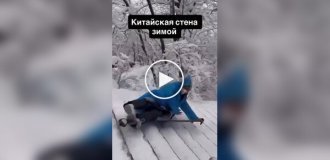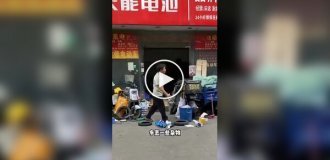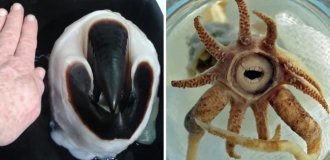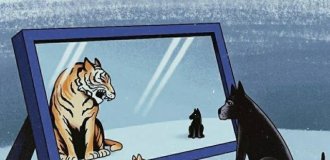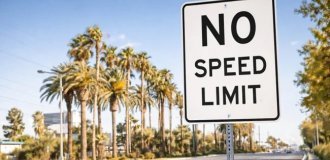Ashgabat - a white marble garden city and the capital of Neutral Turkmenistan (74 photos)
LJ user skitalets writes: In the space of the former Soviet Union there is no country more colorful and at the same time closed to prying eyes than Turkmenistan. The most incredible rumors are circulating about him - and about the universal reverence for Turkmenbashi, and about the insane scale of construction in Ashgabat, and about the total dominance of the special services, and about all kinds of contradictory laws. And last week I had a unique chance to visit there, and not just a simple tourist who does not leave the “elephant path”. but in a slightly different role that allows you to see a little more. 
Naturally, being a great fan of traveling around the post-Soviet territory, I could not miss such a chance, I took a couple of days off and decided to see what kind of country it was and how ordinary working people live there. Looking ahead, I’ll say right away that this trip just completely blew the thread in my head - I didn’t even expect such a number of surreal impressions. But first things first.
I'll warn you right away - I'm not going to make any judgments and I won't talk about politics. As in the case of Georgia, I will only try to show photos and tell what I saw there, and the reader will decide for himself what is really happening there. Of course, I did not look into the “inside out” of the country, there was no possibility, and what is here is nothing more than a “facade” through the eyes of an outsider. And I immediately apologize for the quality of many photos - I didn’t walk much on foot, and photographed mainly on the go from the car at the highest possible ISO.
A portrait of current President Gurbanguly Melyakkulimovich Berdimuhamedov hangs at the entrance of the Turkmenhavayolar aircraft. Immediately upon takeoff, they announce that we are flying not just with an airline, but with the Turkmen Airlines named after the Great President Saparmurat Turkmenbashi. Along the way, they are excellently fed with pilaf or kebab, and at this time you are stunned by the view of the endless desert under the wings.
Upon arrival, locals go one way, foreigners go the other. Moreover, all foreigners entering Turkmenistan must pay a fee of 12 dollars. By the way, a "tourist" visa costs $140. Customs is slow, but rather calm, unlike Uzbekistan, Belarus and Russia.
It is also said that from August 1, all visiting foreigners are under surveillance. To be honest, I never noticed him, especially when we went to the desert 250 kilometers from the capital to watch the hellish burning well of Darvaza. In general, everything was extremely friendly and calm.
The first trip around Ashgabat turned out to be at night. And I'll tell you, it's mind blowing. This city and this country are a completely crazy mix of Dubai, desert, scoop, petrodollars, capitalism and Central Asian flavor. After cold Moscow, offices and flights, what is happening around seems to be complete fantasy.

1.

2. The first impression is a city of luminous buildings, fountains and monuments of Turkmenbashi.

3.

4. Same street during the day

5. Turkmenbashi (“father of the Turkmen”) is the official title of the country's previous president, Saparmurat Niyazov. Until recently, the main attraction of the city was his golden statue on a huge tripod, which rotated after the sun (or did the sun rotate after it?).

6. All together it was called the "Arch of Neutrality". Turkmenistan is the second country in the world after Switzerland that has declared neutrality the main principle of its foreign policy, and even the central national newspaper is called Neutral Turkmenistan. Turkmenbashi always said that he never liked so many portraits and statues of him, and now the new president began to gently turn this desire into reality. Today, the Arch no longer "fits into the concept of the city's development," and the whole thing is being sorted out. I'm sorry I didn't get to see it. The former tripod is on the right, and on the left is a monument to the terrible earthquake of 1948, which completely destroyed the city.

7. The bull symbolizes the strength of the earth, the people on the ball on the left are the victims of the earthquake, and the small child is Turkmenbashi, who fell under this earthquake as a child and lost his mother and two brothers in it. He remained a complete orphan, since his father had died earlier during the war in the Caucasus in 1943.

8. In addition to the "three-legged", there is also the "octopus" - no less monumental monument of Independence, which is depicted onall the money.

9. And here is the monument to "Rukhname" - the holy book written by Turkmenbashi.

10. Every Turkmen learns Rukhnama from school and must know it by heart. It describes the history of the Turkmens, the biography of the Great President, as well as the main commandments and moral principles. Now this entire square is under reconstruction and behind a fence, but earlier, at a certain hour, the book was opened, and the pages of the great history of Turkmenistan came to life with the help of modern multimedia technologies. As a digression, here is one of the expositions of the National Museum, which is worthy of a separate story. The map shows the countries into whose languages the Ruhnama was translated.

11. In continuation of the "night" photos - this is a fountain dedicated to Oguz Khan, the "father" of all Turkmens, according to the same "Rukhname".

12. It is claimed that this fountain complex is the largest in the world in terms of area.

13. Around Oguz are six of his sons, who became the ancestors of the main clans, which later spread across the territory of modern Eurasia (including north to the Ural and Volga regions).

14. An interesting detail on the hand of one of the sons.

15. In fact, the eagle on the Turkmen coat of arms is not two-headed, but five-headed, that is, even wiser than its Russian counterpart.

16. To be even more precise, this is not a coat of arms, but a presidential symbol, and the heads are the five vilayats (regions) into which Turkmenistan is divided. The coat of arms also depicts the Akhal-Teke stallion, which is now being replaced by portraits of Turkmenbashi on the facades of state institutions.

17. But still, there are a lot of monuments, portraits and bas-reliefs of Turkmenbashi - people remember his good deeds and sacredly honor his memory.

18. Police Academy...

19. Olympic Complex...

20. Ministry of Health...

21. Drama theater...

22. Just a monument...

23. Even the city of Krasnovodsk is now called Turkmenbashi.

24. Bas-reliefs and monuments are mostly standing, but the portraits of the old president are gradually being replaced by the new one.

25. A new medical institute (the current president is a doctor by education and former profession).

26.

27. The previous Turkmenbashi at one time decided that having hospitals throughout the country was an unaffordable luxury, and closed hospitals everywhere except the capital - if people need treatment, they will come to Ashgabat, at the same time and look at all the splendor. Well, transport development is also an incentive. At the same time, it cannot be said that Turkmenbashi did not care about the health of the nation - he built the so-called “health path” - a 20-kilometer trekking route along the ridges of the Kopetdag, which every Turkmen must regularly pass in order to stay healthy. The road is illuminated even at night. I will tell you about how we walked along it separately. In general, there were many innovations under him - for example, all months of the year were renamed: January became "Turkmenbashi", some months were named after his mother, father, etc. It was also forbidden to have gold teeth, as it is not worthwhile to flaunt one's wealth, and, in general, one must live modestly. A unique shot - the old president looks at the new one.

28. Screens in the central squares tell about the achievements of the Turkmen neutral state.

29. They are echoed by patriotic posters

30. Local advertising has a national flavor. Nothing superfluous, not even words.

31. Traffic lights and lanterns are also ornamented. At what traffic lights are LED and with a countdown timer.

32. GAI officers stand at EVERY intersection of the city and drive brand new Mercedes.

33. Lots of people in uniform. Serving in the army or law enforcement agencies is prestigious. After 10 o'clock there are almost no cars. This is what a suburban highway looks like at this time.

34. So - city center

35. And so - the city center during the day.

36. The fences on the sides are a reconstruction or construction, in which almost the entire city is located one way or another.

37. I was surprised that there were not so many people on the streets. For example, in the same Tashkent is much more crowded. Either everyone works, or they prefer to sit at home in the heat, or they move by car. Basically, schoolchildren, students, military men and middle-aged women walk the streets.

38. One of the three "gates" of the city (it seems to be the western one).

39. In the middle is another golden statue.

40. Here is the north gate. Also with a profile.

41. In general, the volume of construction is simply amazing. The whole city in new buildings, lined with marble, they are all beautifully lit.

42. Moreover, all marble is imported, there is no one of our own.

43. Ordinary street. All houses are residential.

44.

45. National Library

46. The Ministry of Oil and Gas Industry, popularly referred to as the "lighter".

47. It's the third from the right.

48. And employees of this ministry live in this complex of buildings.

49. Also a residential complex. Ceilings 4 meters.

50. The local "Leaning Tower of Pisa" (also some kind of ministry).

51. Puppet theater.

52.

53. For the leap that the country has made over the past 15 years thanks to oil, gas and the wise leadership of Turkmenbashi, the 21st century is called the "Golden Age of Turkmenistan". This "Altyn Yasyr" is now everywhere - on posters, signs, banknotes. The largest flagpole in the world, which hangs the largest flag in the world (confirmed in the Guinness Book of Records).

54. There is also the world's largest carpet and the world's largest mosque dome, which will also be discussed in the following stories. "Soviet" area. Painfully familiar panels.

55. Old quarters with the private sector are being demolished, and new ones are being built - in a single urban planning concept.

56. It is interesting that all the students wear school uniforms - schoolgirls are green, students are blue. There must be a skullcap and pigtails. If there are no braids, then skullcaps with fake ones are sold.

57. A lot of people are busy in restoring order and cleanliness - almost at every traffic light someone is cutting, watering or sweeping something. Everything is in business.

58. Because of the all-penetrating dust, women are wrapped in scarves, for which they are popularly called "ninjas".

59. I was very pleased that according to the law, smoking is completely prohibited on the streets of Ashgabat. If Sobyanin does the same in Moscow, I agree to the installation of a golden monument to him by Zurab Tsereteli with fountains. Something like this.

60. The Turkmens seemed to me to be generally friendly and hospitable people. For the whole trip for two, we only spent $35 for admission to the National Museum and filming there - and that only because we fought off the escorts for a while and went there on our own. In all other cases, you are almost beaten on the hands when you try to pay in a restaurant or in a market - you are a guest, and in the East this is one of the most respected varieties of Homo Sapiens. There is no discrimination or hostility towards Russian-speaking tourists - everyone willingly speaks Russian, everyone is fluent in it. As for the Russian-speaking people living there, I honestly don’t know, there was no opportunity to communicate. Everyone is talking, including about the abolition of dual citizenship, but airport employees with Russian names and surnames on their badges came across. The city is completely safe, crime is zero, cars are not closed, even the executive class. At night, unlike the same Tashkent, you can walk quite calmly. Where cars pose a greater danger - they don’t slow down before crossings, they can calmly crush them. And the people don’t even bother - everyone moves where they want.

61. In general, the people are friendly and hospitable. No extremism, fanaticism or aggression. The state is secular, there are only about 5 mosques in Ashgabat, the people are not particularly religious, and even more so there is no question of any fundamentalism. Everything is under control, everything is calm.

62. It is also amazing that there are absolutely no beggars, vagabonds and other asocial elements in the city. In the same Uzbek cities of the "Silk Road" (Khiva, Bukhara, Samarkand) or Cambodia, crowds of children and beggars attack you. Immediately, all people are provided with food, gas, gasoline and a roof over their heads. Lenin monument. Naturally, also with fountains.

63. It is interesting that it was built at the dawn of Soviet power, during the struggle of Comrade Sukhov with the Basmachi.

64. Pushkin is also held in high esteem - there is a street named after him, a theater, a Russian school, as well as a monument from tsarist times.

65. Strange fruit on the pavement.

66. Monument to the victims of the Great Patriotic War.

67. Soldiers on the edges - one to one as in the Treptow Park in Berlin.

68. True, the eternal flame for some reason lost its eternity, despite the colossal gas reserves.

69. There are only four state channels, so every house has a bunch of satellite dishes hanging to increase reception.

70. Oriental flavor

71. Nothing is forbidden, the Internet is also completely accessible. All people can safely go abroad, they regularly fly to Dubai for vacation and for cars and goods. There would be money. There is no tension with food either. Weddings are arranged for 400-600 people, tables are breaking. Although we tried to fight off a huge number of all kinds of Central Asian satiety, we still ate to satiety every day, giving ourselves a vow that in the morning we become strict vegetarians. When you cut tomatoes, the smell is distributed throughout the room, and peaches just melt in your mouth. In short, nonsense. I especially liked the chebureks...

72. ...and the national Turkmen soup "unash" (in fact, the same lagman)

73. When you walk through the streets of Ashgabat, the feeling of complete unreality of what is happening does not leave. Indeed, the Golden Age.

74. A real oasis in the middle of a bare desert.


